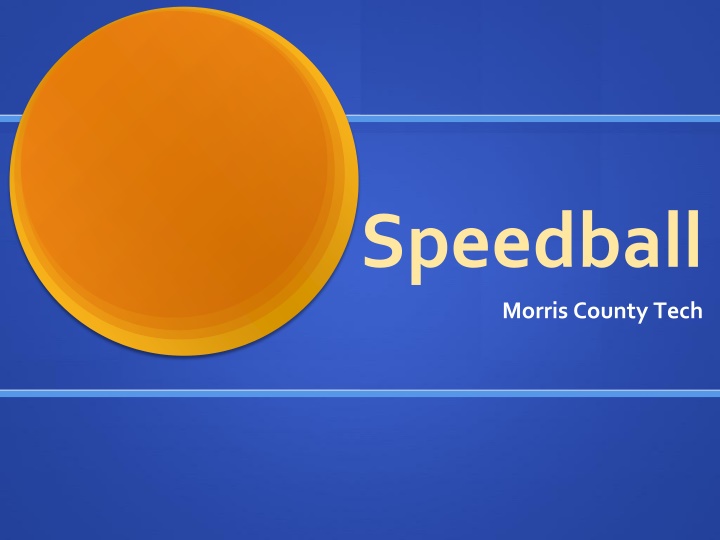
Fast Facts About Speedball: History, Rules, and Scoring
Learn about the origins of Speedball, a unique team sport created in 1921 by Elmer Mitchell at the University of Michigan. Discover the rules of the game, from ball handling to scoring, and understand key infractions to avoid while playing. Explore the exciting blend of soccer, football, and basketball elements that make Speedball a dynamic and engaging team sport.
Uploaded on | 0 Views
Download Presentation

Please find below an Image/Link to download the presentation.
The content on the website is provided AS IS for your information and personal use only. It may not be sold, licensed, or shared on other websites without obtaining consent from the author. If you encounter any issues during the download, it is possible that the publisher has removed the file from their server.
You are allowed to download the files provided on this website for personal or commercial use, subject to the condition that they are used lawfully. All files are the property of their respective owners.
The content on the website is provided AS IS for your information and personal use only. It may not be sold, licensed, or shared on other websites without obtaining consent from the author.
E N D
Presentation Transcript
Speedball Morris County Tech
History Speedball was created in 1921 by Elmer Mitchell (Football and Basketball coach, and Director of Intramural Athletics) @ the University of Michigan He created a game that meshed the best parts of popular sports and did away with the undesired parts. all of Speedball combines elements of soccer, football and basketball to create a vigorous team game played by many.
Rules 1. Play begins with a jump ball 1. Any time the ball touches the ground, players are forbidden to touch the ball using their hands/arms. Play must resume by kicking with the feet (soccer) 1. Transition from feet to hands must be made by catching a ball in the air. You may not catch from a bounce off the floor
Rules Continued 4. A player may never run with the ball. Upon catching the ball a player must stop as soon as possible and establish a pivot foot. Any further movement is considered traveling. 5. Once stopped, a player has a maximum of ten seconds to pass, drop or punt the ball. 6. Any time an aerial pass is incomplete or knocked down inbounds, play continues as a grounded ball.
RULE INFRACTIONS Traveling with the ball - Receivers are given a reasonable distance to stop once they catch a thrown ball. Intentional juggling or fumbling a thrown ball will result in a traveling violation. Illegal use of the hands - Touching a ground ball with the hands or arms. A ground ball must be lifted entirely above the receiver's waist to be played with the hands or arms. Interference - Interfering with a penalty kick or throw-in. Dangerous play All high kicks above the waist in a dangerous manner will be prohibited.
RULE INFRACTIONS Obstruction - Obstruction is the intentional act by a player, not in possession of the ball or not attempting to play the ball, of running between an opponent and the ball or using the body as an obstacle. Stalling - When a player in possession of an aerial throw retains possession while marked by a defender and the defender has completed the verbal 10-second count. Closely guarded - When a defensive player marking an offensive player with the ball is closer than 18 inches to that player. Violation Penalty: The penalty for a violation is that the opponents are awarded possession of the ball for an aerial throw at the spot of the foul. The defense must take a position at least 3 yards (9 feet) from the thrower, or at the goal line if within 3 yards of the goal line.
Scoring Touchdown (1 point) is scored when the ball thrown by a player, outside of the end zone, and legally caught by a teammate in the end zone. Field goal (2 points) is scored when the ball is kicked from outside the end zone so that the whole of the ball completely crosses the goal line into the goal.
